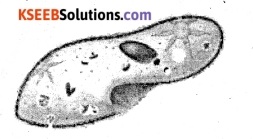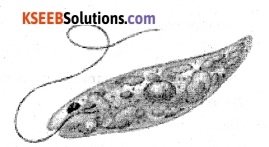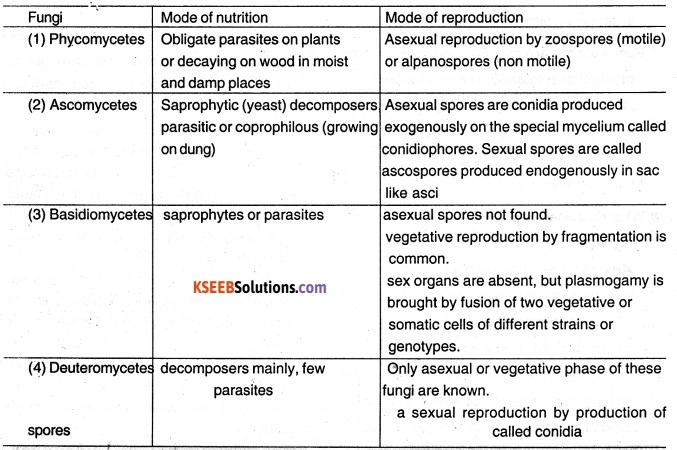You can Download Chapter 2 Biological Classification Questions and Answers, 1st PUC Biology Question Bank with Answers, Karnataka State Board Solutions help you to revise complete Syllabus and score more marks in your examinations.
Karnataka 1st PUC Biology Question Bank Chapter 2 Biological Classification
1st PUC Biology Biological Classification NCERT Text Book Questions and Answers
Question 1.
Discuss how classification systems have undergone several changes over a period of time?
Answer:
Classification was born instinctively out of a need to all organisms for our own use since the dawn of civilization. Aristotle was the earliest to attempt a more scientific basis for classification. He used simple morphological characteristics to classify plants into trees, herbs and shrubs. He also divided animals into Animals with red blood and those who do not have red blood. Linnaeus proposed two-kingdom system of classification with Plantae and Animalia including plants and animals respectively.
The above system did not distinguish eukaryotes and prokaryotes, unicellular and multicellular, photosynthetic and non-photosynthetic organisms. A need was felt for including besides gross morphology, other characteristics like cell structure, nature of cell wall, mode of nutrition, habitat, method of reproduction, evolutionary relationships etc., Recently R.H. Whittaker proposed a five-kingdom classification to answer above the Five kingdoms are
- Monera
- Protista
- Fungi
- Plantae
- Animalia.
![]()
Question 2.
State two economically Important uses of:
(a) heterotrophic bacteria
(b) archaebacterla
Answer:
(a) heterotrophic bacteria:
- helpful in making curd from milk
- fixing of nitrogen in legume roots etc.
(b) Archaebacteria:
- Methanogens are present in the guts of several ruminant animals such as cows and buffaloes. They are responsible for the production of methane from ruminating animal dung.
- Archaebacteria a live in harsh habitats salty areas, hot Springs which may give evidence on how life might have evolved on earth.
Question 3.
What Is the nature of cell-walls in diatoms?
Answer:
In diatoms ail walls form two thin overlapping shells which fit together as in a soap box. The walls are embedded with silica and thus the walls are indestructible. Thus diatoms have left behind large amount of cell walls deposits in their habitat.
Question 4.
Find out what do the terms ‘algal bloom’ and ‘red-tides’ signify.
Answer:
Algals usually form huge colonies and are called ‘Algal bloom’ formed by their multiplying in a rapid rate. Dinoflagellate have different colours based on pigments. “Algal bloom” of Red dinoflagellate gives a red appearance to the part of sea in which it is present, hence called ‘Red Tide’.
Question 5.
How are viroids different from viruses?
Answer:
Viroids are free RNAs without protein Coat, whereas, viruses have RNAs encapsulated in a protein coat.
![]()
Question 6.
Describe briefly the four major groups of Protozoa.
Answer:
(a) Amoeboid protozoa:
These organisms live in fresh water, sea water or moist soil. They move and capture their prey by putting out pseudopodia (false feet) as in Amoeba. Marine forms have silica shells on their surface. Some of them such as Entamoeba are parasites.
(b) Flagellated protozoa:
The members of this group are either free-living or parasitic. They have flagella. The parasitic forms cause diseases such as sleeping sickness. Example: Trypanosoma.
(c) Ciliated protozoa:
These are aquatic, actively proving organisms because of the presence of thousands of cilia. They have a cavity (gullet) that opens to the outside of the cell surface. The co-ordinated movement of rows of cilia causes the water laden with food to be steered into the gullet. Example: Paramecium

(d) Sporozoans: This includes diverse organisms that have an infectious spore-like stage in their life cycle. The most notorious is Plasmodium which causes malaria which has a staggering effect on human population.
Question 7.
Plants are autotrophic. Can you think of some plants that are partially heterotrophic?
Answer:
Bladderwort and venue fly trap are example of insectivorous plants and cuscuta is a parasite. These are plants which are partially heterotrophic.
Question 8.
What do the terms phycobiont and mycobiont signify?
Answer:
Lichens are symbiotic associations between algae and fungi. The algal component is known as phycobiont and fungal component as mycobiont, which are autotrophic and heterotrophic, respectively. Algae prepare food for fungi and fungi provide shelter and absorb mineral nutrients and water for its partner.
Question 9.
What are the characteristic features of Euglenoids?
Answer:
Characteristic of Euglenoids:

- fresh water organisms found in stagnant water.
- Instead of a cell wall, they have a protein rich layer called pellicle which makes their body flexible.
- They have two flagella, a short and a long one.
- They are photosynthetic in the presence of sunlight, but behave like heterotrophs by predating on other small organisms in absence of sunlight
- pigments are identical to those present in higher plants
Example: Euglena
![]()
Question 10.
Give a brief account of viruses with respect to their structure and nature of genetic material. Also, name four common viral diseases.
Answer:
Viruses have protein capsule and genetic material inside. Viruses are non cellular organisms that are characterized by having an inert crystalline structure outside the living cell. Once they infect a cell they take over the machinery of host cell to replicate themselves killing the host.

Generally protein that infect plants have single standard RNA and Viruses that infect animals have either single or double stranded DNA. Bacteriophage usually have double stranded DNA. Where as TMV contain single stranded RNA. Four common Viral diseases
- AIDS
- Mumps
- Small Pox
- Harpies
Question 11.
Give a comparative account of the classes of Kingdom Fungi under the following:
(i) mode of nutrition
(ii) mode of reproduction

Question 12.
Organise a discussion in your class on the topic-Are viruses living or nonliving?
Answer:
Living characteristics:
- Viruses replicate inside host cell
- Viruses are capable of taking over machinery of host cell
- They have either DNA or RNA cell genetic material which is found
in cell living organism as genetic material
Non living characteristics:
- Out side host cell Viruses are inert
- They do not have cell structure.
- Viruses can be crystallised